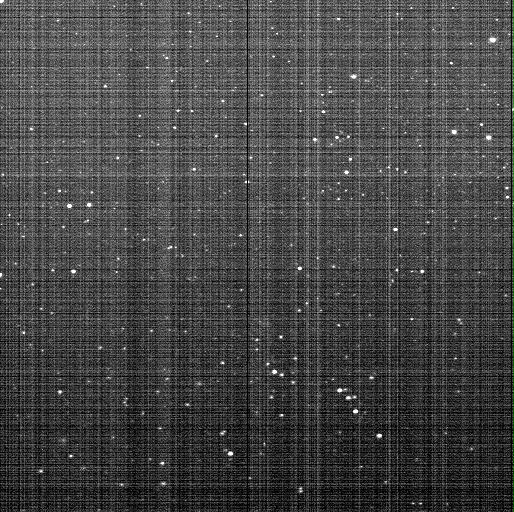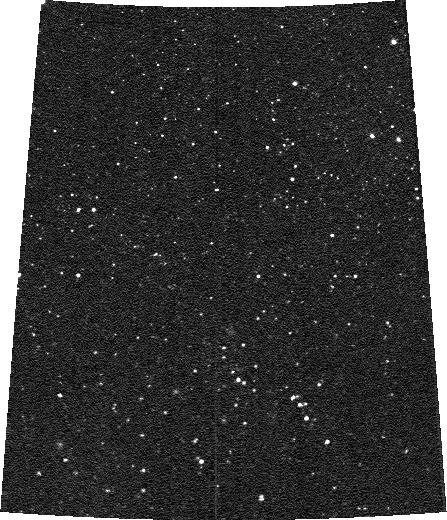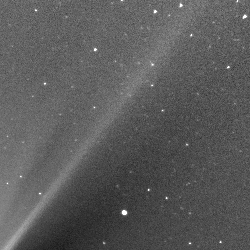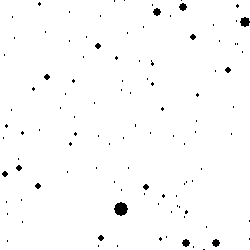Japanese version Home Page Updated on October 13, 2003
Examination of Public Images of Automated Surveys1. OverviewNow we are in the generation of automated survey. Many latest images photographed automatically come to be available immediately via Internet these days. The MISAO Project are investigating those public images available via Internet using the PIXY System 2, and searching new stars. Now we are checking the following three web sites. Tomoyuki Itou's library All Sky Automated Survey (ASAS-3) SOHO LASCO C3 images These sites have different rules and styles on schedule of photographing, method to access to the images, and so on. The PIXY System 2 has a framework of agent. Therefore, we created an agent for each site, in which the concrete file names, concrete method to download the images, etc., are implemented. The PIXY System 2 can load those agents as plug-in. As as result, just pushing one button, the system automatically downloads the images, compares to the Guide Star Catalog (GSC) or Tycho Catalogue, finds candidates of new stars, and creates an HTML gallery. Here is an example of the HTML gallery created by the PIXY System 2. In the HTML gallery, the candidates of new stars are displayed with the past images previously registered to the database, or the Digitized Sky Survey (DSS) images. So it is easy to check whether those candidates are real or not at a glance. 2. Tomoyuki Itou's libraryhttp://www.kcv.ne.jp/~totomo/tosyokan/ Tomoyuki Itou's library provides images of every night, photographing the sky at south automatically all night. One image covers 15x15 degree area, and contains 8.5 mag stars in good condition. Here is an example of an image available at Tomoyuki Itou's library. 
The image is photographed in a special style using a linear CCD chip. Because the image is mapped in Mercator projection, the PIXY System 2 cannot compare it to the Tycho Catalogue as is. We also find some lattice pattern on the image. Therefore, the agent of Tomoyuki Itou's library operates some image processing, to convert the mapping and remove the lattice pattern. The image after processed becomes as follows. 
In the case of Tomoyuki Itou's library, it creates an HTML gallery which shows two images on the same night, and one image of the past previously registered to the database. It only shows stars detected at the same position from two images in order to suppress false alarms. Here introduces an example of candidates detected from Tomoyuki Itou's library images. J220652.26-122655.0
A bright star, not visible on 2003 July 25, was detected from the images on Oct. 4. Actually, it is Uranus. 3. All Sky Automated Survey (ASAS-3)http://archive.princeton.edu/~asas/ The ASAS-3 is famous for the pre-discovery observations of Nova Sgr 2003 from the early brightening phase in 2003 April. It repeatedly surveys southern sky up to Decl. +30 degree, once per several days. The images become available via Internet immediately. The images contain down to about 14 mag stars. In order to view the ASAS-3 images at the web site of the All Sky Automated Survey, we need to follow some steps as follows.
The MISAO Project created an agent which operates those steps automatically. Then, just pushing one button, the system automatically downloads the images, compares to the Guide Star Catalog (GSC), finds candidates of new stars, and creates an HTML gallery. In the case of the ASAS-3, it creates an HTML gallery which shows the ASAS-3 images with the Digitized Sky Survey (DSS) images. Here introduces an example of candidates detected from the ASAS-3 images. J222037.91-044458.6
There is a bright star in the ASAS-3 image, which cannot be found in the Digitized Sky Survey (DSS) image. Actually, it is a comet 29P/Schwassmann-Wachmann 1, which became bright in outburst in late September, 2003. As this example implies, the latest activity of comets can be monitored in the ASAS-3 images. So I created the following web page. Recent Images of Comets in ASAS-3 4. SOHO LASCO C3 imageshttp://sohowww.nascom.nasa.gov/data/realtime-images.html The SOHO web site provides the images around the Sun photographed by a spacecraft, per several dozens of minutes every day. One image covers 15x15 degree area, and contains down to about 9 mag stars. Because the SOHO LASCO C3 images have many noises, it is too hard to select real new stars among noises. The noises also disturb the PIXY System 2 to solve matching between the image and Tycho Catalogue data. Therefore, the agent of the SOHO LASCO C3 images overlaps three images photographed at almost same time, and creates an median image. Then it searches new stars from the median image. Here is an example of the median image. The left one is the original SOHO LASCO C3 image. The center one is the median image created by the agent. The right one is the Tycho Catalogue chart of the same field. We can see the noises are deleted in the median image, and it becomes easy to compare to the chart.
In the case of SOHO LASCO C3 images, it creates an HTML gallery which shows the SOHO LASCO C3 images with the Digitized Sky Survey (DSS) images. It also checks the image of the previous day, and only shows stars detected at the same position from two images (on that day and the previous day) in order to suppress false alarms. Here introduces an example of candidates detected from the SOHO LASCO C3 images. J124000.18-113721.1
A bright star was detected from the SOHO LASCO C3 images on two days, which is not recorded in the Tycho Catalogue. Looking at the Digitized Sky Survey (DSS) image, it is M104 (Sombrero Nebula).
|











